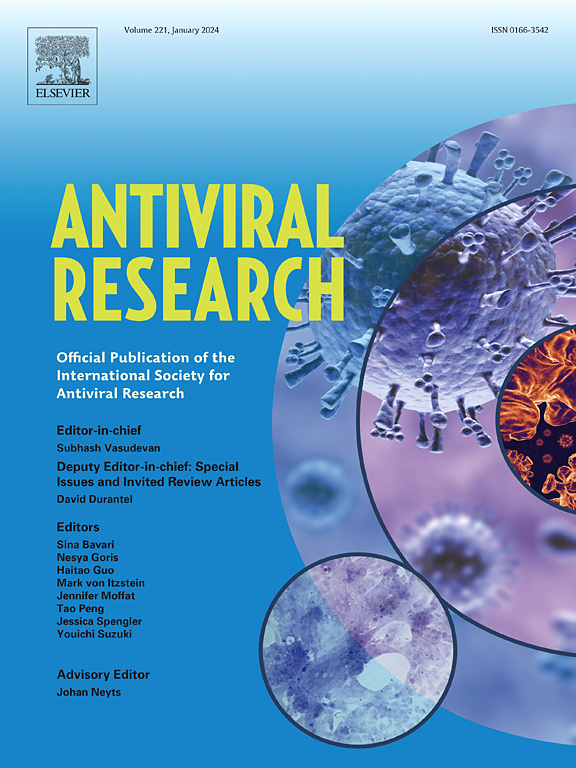Mechanisms of action of repurposed Ebola virus antivirals – the roles of phospholipidosis and cholesterol homeostasis
IF 4.5
2区 医学
Q1 PHARMACOLOGY & PHARMACY
引用次数: 0
Abstract
Cell-based drug repurposing screens have been a common approach to identifying compounds with antiviral properties. For Ebola virus (EBOV), such screens yield unexpectedly high hit rates. We investigated two mechanisms underlying the anti-EBOV activities of repurposed compounds. Phospholipidosis (PLD) is excessive accumulation of cellular lipids that confounds screens for SARS-CoV-2. We performed a meta-analysis of published screens and supplemented these with our own using infectious EBOV at biosafety level-4. A list of nearly 400 hit compounds from seven anti-EBOV screens was compiled. Most (63 %) of these hits were predicted to induce PLD, and their anti-EBOV activities broadly correlated with PLD induction. PLD-inducing compounds did not inhibit infection by several other highly pathogenic viruses, suggesting that PLD was not a confounding factor for screens against Lassa, Crimean-Congo hemorrhagic fever, and Rift Valley fever viruses. Of four cells lines tested, HeLa cells were the least susceptible to PLD induction. In addition to PLD, many of the hit compounds identified disrupt cholesterol homeostasis. Previous research found inhibition of cholesterol synthesis by statins blocked EBOV infection. To understand if compounds inhibiting this mechanism could contribute to high hit rates, we further examined this pathway. We identified multiple additional inhibitors of cholesterol biosynthesis, that also blocked EBOV infection, albeit with varying potency and cytotoxicity across cell lines. EBOV inhibitors that acted through this mechanism were suppressed by the addition of exogenous cholesterol. Our findings help define the effects that contribute to anti-EBOV activities and hence facilitate the selection of lead molecules suitable for subsequent development.
重组埃博拉病毒抗病毒药物的作用机制——磷脂病和胆固醇稳态的作用
基于细胞的药物再利用筛选是确定具有抗病毒特性的化合物的常用方法。对于埃博拉病毒(EBOV)来说,这种筛选产生了意想不到的高命中率。我们研究了再利用化合物抗埃博拉病毒活性的两种机制。磷脂沉积症(PLD)是指细胞脂质的过度积累,它阻碍了对 SARS-CoV-2 的筛选。我们对已发表的筛选结果进行了荟萃分析,并利用生物安全等级为 4 级的传染性 EBOV 对我们自己的筛选结果进行了补充。我们从七个抗 EBOV 筛选中筛选出了近 400 个命中化合物。其中大多数(63%)化合物被预测会诱导 PLD,它们的抗 EBOV 活性与 PLD 诱导大致相关。诱导 PLD 的化合物并不抑制其他几种高致病性病毒的感染,这表明 PLD 并不是针对拉沙病毒、克里米亚-刚果出血热病毒和裂谷热病毒筛选的干扰因素。在测试的四种细胞系中,HeLa 细胞对 PLD 诱导的敏感性最低。除 PLD 外,发现的许多命中化合物还会破坏胆固醇的稳态。以前的研究发现,他汀类药物抑制胆固醇合成可阻止 EBOV 感染。为了了解抑制这一机制的化合物是否会导致高命中率,我们进一步研究了这一途径。我们还发现了多种胆固醇生物合成抑制剂,它们也能阻断 EBOV 感染,只是在不同细胞系中的效力和细胞毒性各不相同。通过这种机制发挥作用的 EBOV 抑制剂会受到外源胆固醇的抑制。我们的研究结果有助于确定导致抗 EBOV 活性的效应,从而有助于选择适合后续开发的先导分子。
本文章由计算机程序翻译,如有差异,请以英文原文为准。
求助全文
约1分钟内获得全文
求助全文
来源期刊

Antiviral research
医学-病毒学
CiteScore
17.10
自引率
3.90%
发文量
157
审稿时长
34 days
期刊介绍:
Antiviral Research is a journal that focuses on various aspects of controlling viral infections in both humans and animals. It is a platform for publishing research reports, short communications, review articles, and commentaries. The journal covers a wide range of topics including antiviral drugs, antibodies, and host-response modifiers. These topics encompass their synthesis, in vitro and in vivo testing, as well as mechanisms of action. Additionally, the journal also publishes studies on the development of new or improved vaccines against viral infections in humans. It delves into assessing the safety of drugs and vaccines, tracking the evolution of drug or vaccine-resistant viruses, and developing effective countermeasures. Another area of interest includes the identification and validation of new drug targets. The journal further explores laboratory animal models of viral diseases, investigates the pathogenesis of viral diseases, and examines the mechanisms by which viruses avoid host immune responses.
 求助内容:
求助内容: 应助结果提醒方式:
应助结果提醒方式:


